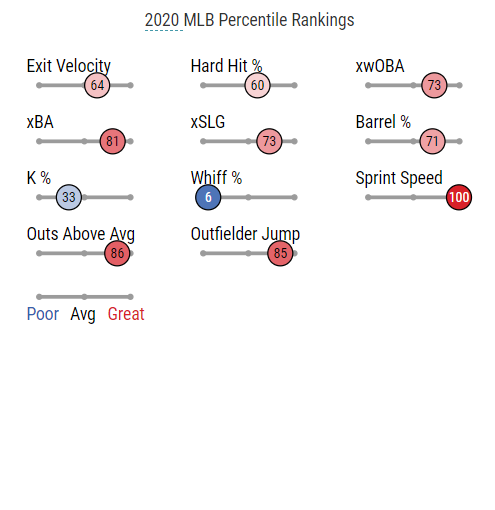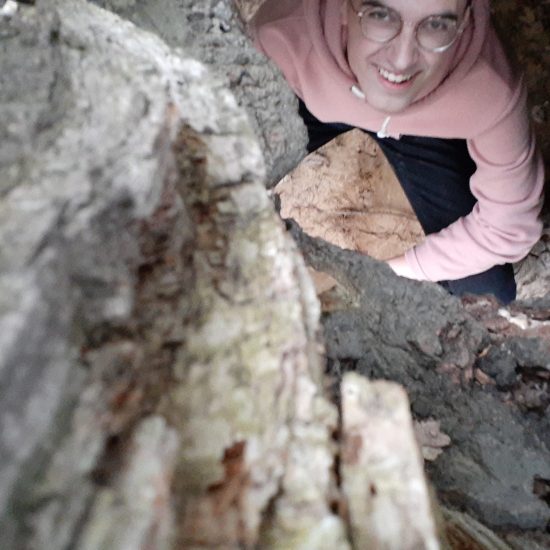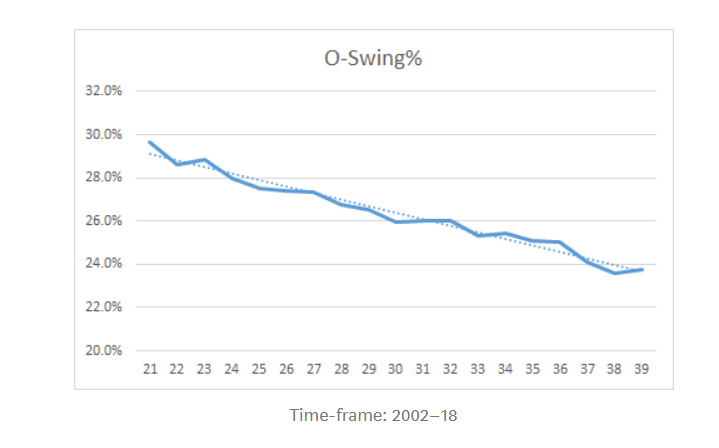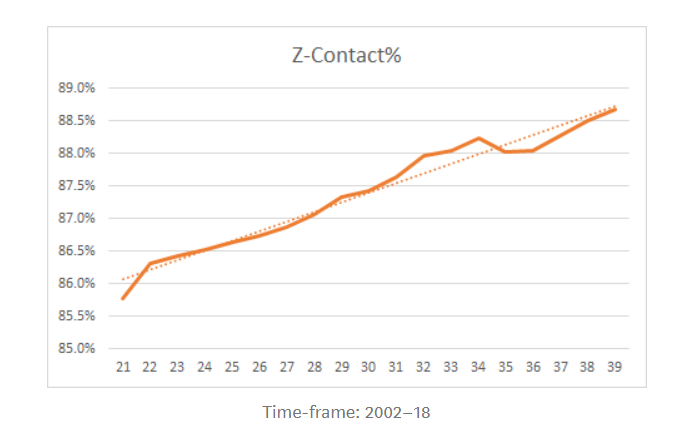Luis Robert has taken the league by storm so far in his young career. He’s tied for third in baseball for fWAR (.9), has played an excellent center field, and put up otherworldly numbers with the bat. While his White Sox have been middling, it’s fair to suggest that no player in his division has had as much impact as Robert.
As fantasy players, we look at Robert’s imprint this far and get excited. He’s young, he’s fun, he’s fast; he’s all the things we enjoy when playing fantasy. Robert gives us plenty of reasons to be excited about his abilities, but also presents some warts. Fortunately, while these concerns might affect Robert’s season this year, there’s every reason to believe that, in the long term, Robert will be a star.
How Robert Is Succeeding
https://gfycat.com/brokenforcefulcarp
Robert has started off the year crushing everything pitchers are throwing him. He’s hitting over .320 with an ISO over .170, something only 15 other players have managed so far this year. He’s also looked good in the Baseball Savant data, as nearly every metric measures him as 60th percentile or better.
 When we look at this data, it’s helpful to remember that its descriptive and not predictive. These numbers show us that Robert’s excellent surface-level stats are not wholly fluky. After all, it’s rare for a player to hit this well without getting enormously lucky, but Robert’s tendency to hit the ball hard, combined with 100th percentile speed, shows that he’s the driving force behind at least some of the numbers.
When we look at this data, it’s helpful to remember that its descriptive and not predictive. These numbers show us that Robert’s excellent surface-level stats are not wholly fluky. After all, it’s rare for a player to hit this well without getting enormously lucky, but Robert’s tendency to hit the ball hard, combined with 100th percentile speed, shows that he’s the driving force behind at least some of the numbers.
In fact, not only do these average numbers look good, but the max numbers look even better. Max exit velocity as a statistic does a poor job of reflecting how consistently well a player has done up to this point, but a much better job of being predictive of how a player will perform in the future. The average numbers we see with it establish a baseline for how a player has performed in general, not focusing on one special moment.
Imagine a pitcher who trudged through a game. He got hit hard a few times and had poor CSW numbers, but his defenders behind him played well, the batters on the opposing team weren’t locked in, and he got lucky with a quality start. The average reflection of how he performed will show that he was valuable, and the team was better for his performance. And that’s true — he helped them win. But that performance isn’t a predictor of success to come so much as a reflection of a successful Toby.
On the other hand, imagine a pitcher who comes out and looks dominant. He’s inducing whiffs, getting lots of called strikes, and passes the eye test. However, he leaves a slider hanging over the middle of the plate immediately after giving up a bloop single and a full count walk, and the batter blasts a ball over the center-field fence. He may have given up three runs in five innings and gotten saddled with the loss, but the peaks of his performance were predictive of a possible ace hiding away.
Exit velocity works in much the same way.
Look at how varied Robert’s exit velocities have been this year. His average exit velocity has been merely good not because he doesn’t have the ability to crush a ball, but instead because he’s had a relatively outsized number of balls hit poorly. The thirteen batted balls he’s hit at over 100 MPH this year are impressive this early in the season, but even more impressive is the ball hit at the very end of that graph. Only three players in all of baseball have had a batted ball event fall into that category this year. Robert shares membership in an exclusive club with Pete Alonso and Giancarlo Stanton, showing just how much thump potential he can show off when he hits a ball perfectly.
He’s also more than just a potential power tower. He has elite speed, too, reaching 29.4 MPH at his peak so far this year. Up to this point, that’s second in all of baseball, which shows itself on game day when he plays defense and runs the basepaths. Robert already has four steals this year, which is more than 11 teams have total and is especially impactful in a season where fewer stolen bases are occurring than ever before. Robert has more steals than any player not on the San Diego Padres and, in a fantasy environment where players like Mallex Smith are drafted for no reason other than that they provide stolen bags, that provides a comforting fantasy floor for Robert.
As a word of caution before we become too enraptured with Robert’s sprint speed, while 29.4 MPH is certainly excellent, in most seasons it would not place him 2nd in baseball. In 2019, Robert would have been placed in a 9-way tie for 24th in baseball, at the same speed as players like Ronald Acuna Jr, Tommy Edman, and the aforementioned Mallex Smith. For each of these players, speed is an asset for them, but they’re not in the otherworldly tier of Byron Buxton and Tim Locastro. It can be tempting to look at Roberts ranking compared to other players and call his speed an 80-grade tool, but its closer to a 70-grade asset.
That speed shows up in Robert’s defense just as much as it does his baserunning. I watched a few White Sox games earlier this year when they were playing the Twins, as well as this week as I was working on research for this article, and the best way to describe Robert’s defensive prowess is to say that he glides to the ball. There are few centerfielders who can reach balls all over the outfield and make it seem effortless, and Robert is already one of them. No defensive metric stabilizes quickly enough to show whether or not Robert is a plus defender yet, but he passes the eye test with flying colors.
How Robert Could Fail
Back to back sliders from Tyler Johnson.
Back to back whiffs from Luis Robert. pic.twitter.com/PGj7iBfqUy— Alex Fast (@AlexFast8) July 13, 2020
Earlier this year, during summer camp, there was a general buzz around the baseball world that LuBob was having trouble hitting offspeed pitches, especially sliders. This tweet from our own Alex Fast was far from the most worried about Robert, but it’s worth including because it does a good job of showing just how lost Robert looked. The general consensus was that Robert might hit fastballs hard this year, but if pitchers start to wise up and throw him offspeed pitches, especially sliders, he would struggle.
There are 244 hitters who have seen at least 50 pitches so far this season.
Who has seen the lowest rate of fastballs (4-seamers/2-seamers/sinkers)?
Luis Robert: 30.5%
— Andrew Simon (@AndrewSimonMLB) July 30, 2020
Unfortunately for Robert, pitchers were onto his potential weakness instantly. He’s performed decently against offspeed pitches up to this point, especially against sliders and curveballs, but a closer look at his statistics against those pitches shows some troubling red flags. Robert has hit .316 against sliders to this point, garnering six hits in 19 ABs, but that has come largely off a BABIP north of .500 in those instances. Even more concerning, of the 19 ABs he’s had that ended in a slider, nine ended in a strikeout. Robert may be able to hit a slider hard when he runs into one, but he’s still shown a tendency to whiff on those pitches. Robert’s overall BABIP numbers look only slightly lucky this far, especially accounting for his speed, but he’s gotten lucky on offspeed pitches while getting unlucky on fastballs. As each of these numbers continues to regress towards the mean, we’ll recognize that Robert is indeed better against fastballs than offspeed pitches.
All those strikeouts against sliders lead us to the other of Robert’s red flags, however. Robert has long had questions about his plate approach. Back in November, Phil Goyette of Prospects Live wondered, “How much will his hit tool hold him back? Our Jason Kamlowsky praised the mechanics and balance of his swing in an April look, but also noted the aggressive approach and pitch recognition failings could be holding the hit tool down. With a K-BB% hovering stubbornly near 20 percent, Robert’s batting average will continue to be a wild ride. And his low walk rate is something to consider in OBP leagues.”
The first few days of the season did not speak well for Robert proving those doubts wrong. In his first eight games this year, Robert collected only one walk, coupled with a strikeout rate much too high for most to stomach. Couple that with a whiff rate north of 25% — worst in baseball up to this point in the season — and Robert’s plate approach seems seriously concerning.
Since August began, Robert has started to become dramatically better at taking the free pass. In the past six days, Robert has taken four walks, and, while his BB% is still below league average, its well within the range of normalcy. A player who came up looking like he would walk about as often as his teammate Tim Anderson has instead walked about as often as Hunter Dozier’s mark since opening day 2019. Dozier is nothing special when it comes to laying off pitches, but he’s a perfectly acceptable middle of the road.
It’s fair to expect that Robert’s plate approach will continue to fluctuate wildly, as it has up to this point in the season. He is, after all, a 23-year-old rookie in a season where most pitchers seem to be ahead of hitters. (Indeed, in the game between when I finished writing this article and the article was posted, Robert produced a golden sombrero, proving that he’s no Luis Arraez.) Rostering Robert this year will be a roller coaster. Long term, however, signs point to Robert’s plate approach continuing to improve.
In January of this year, Matt Hartzell wrote an article about aging curves in baseball as it has to do with skills (instead of many aging curve models, which tend to look at the results of those skills.) It’s a fascinating article, and I highly recommend you give it a read, but allow me to show a few graphs he created. These show how players’ o-swing% and z-contact% change as they age.
O-Swing%, or chase rate, measures how often a player swings at a pitch outside of the strike zone. As I already mentioned, a lot of analysts have expressed concern at Robert’s tendency to swing at breaking balls that end up outside of the strike zone. Fortunately for Robert, O-Swing% has one of the most pronounced aging curves of all skills within baseball. While many skills increase up until a player is in their mid to late 20s and then begins to decrease, O-Swing improves all the way until the age of 38. Robert currently has an absolutely horrendous 46% chase rate but has improved dramatically even through the course of the season thus far. If he continues to improve exponentially now, as he begins to familiarize himself with big league pitches and then continues steady growth like shown in this graph, he could improve to the point where its no longer a significant problem. Robert’s tendency to chase pitches is bad, but it’s far from the most worrying failure he could have.
Z-Contact% measures how often players make contact on pitches they swing at inside of the zone. It’s like the cousin to whiff rate, in that it measures a batter’s whiffs, but only on pitches that they probably should have hit because the pitch was inside the strike zone. This relates to Robert in a similar vein as O-Swing does. Robert has a tendency to swing and miss, as shown by his 25% whiff rate. That number doesn’t directly correspond to this graph — one stat measures all pitches, the other only those within the zone — but nonetheless, his swing and miss numbers are a major problem. Fortunately, this once again appears to be a skill that improves with time, even after a player passes his physical peak. That’s not to say that these swing and miss problems aren’t concerning, but it does show me that this is a skill that should be fixable as Robert ages.
Conclusion
The day before this piece went up, Craig Edwards of FanGraphs published an article about Robert. In it, he looked at some of the same things I did in this article. At first, I panicked, wondering if I should even ask my section manager to publish this article. But as I compared this pieces, I realized we came to a lot of different conclusions. Neither of us is necessarily right or wrong — baseball’s volatility is part of what makes it so great — but I think it’s helpful to read both and come to your own conclusions. After all, Robert is a rookie who’s been on a major league roster for all of two weeks. Nobody knows exactly what to make of him.
Part of why it’s so difficult to evaluate Robert is that he’s clearly special. When we look at him, it’s easy to jump to conclusions. Robert’s a ton of fun, he’s looked great, and we all want to be some of the first ones to be in on the next Mike Trout. We can look at the max exit velocity he’s created this year and claim that he’ll one day hit as many home runs as Giancarlo Stanton did in his magical MVP year. We could look at his second in baseball sprint speed this year and claim that he’s as fast as Byron Buxton.
Instead, we have to realize that those skills aren’t necessarily going to vault a player to stardom on their own. Robert can hit the ball extremely hard, but his average exit velocity to this point has been fairly middling. He’s fast, but he’s nearly two full FPS slower than a full sprint Buxton when Buxton is healthy.
Others might have a tendency to look at Robert and panic. His hit tool isn’t yet what we want it to be. He strikes out more than we would prefer, and he chases sliders out of the zone. There’s no way his production so far is sustainable — he could be about to fall off a cliff and become a replacement-level player.
Overall, it’s helpful to remember that Robert is a rookie, who’s never played in the highest level of the game before. He’ll have peaks, like he’s having right now, but he’ll also have valleys. There will be times this year where his hit tool will come back to bite him and he’ll strike out four times in a game. It will happen.
But we also see promise. All of Roberts’s most worrying traits will improve with time, while many of his best traits will remain, if not improve. Robert will mature and grow and, in a few years, he’ll probably be a fantasy superstar. Right now and for next season, the market probably overvalues him, seeing the highs and ignoring the lows. Consider taking advantage of that and selling high this season. And, for those of you in dynasty leagues, buy him after one of those lows, before he succeeds once again and his dynasty price matches the levels of a young stud like Fernando Tatis Jr.
After all, Robert might be a prince right now, but soon he will be a king.
Featured Image by Justin Paradis (@freshmeatcomm on Twitter)




Great read.
Thank you so much, Will! Glad you liked it!
You are becoming a must read. Appreciate your careful analysis with the realization that Roberts is young and therefore you are giving the best guess you can.